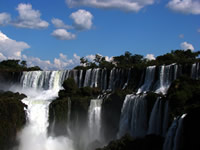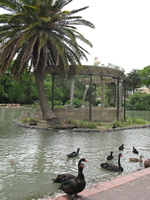INFORMATIONSPANISH COURSESSPANISH RESOURCESABOUT ARGENTINAVIDEOSOTHER RESOURCES |
☞ Home
☞ Flora and Fauna
FLORA AND FAUNA IN ARGENTINA
Argentina is divided into varying provinces and regions. The regions are composed of 20 different provinces containing: Buenos Aires, Catamarca, Chubut, Cordoba, Correntes, Entre Rios, Jujuy, La Rioja, Mendoza, Misiones, Neuquen, Rio Negro, Salta, San Juan, San Luis, Santa Cruz, Santa Fe, Sgo. Del Estero, Tierra del Fuego, and Tucuman.
The various regions are comprised of a wide array of geographical formations, each attracting tourists for tango, adventure sports, history, villages, thermal springs, and everything in between.
Northwest region: The northwest region is mostly mountainous, giving the viewer outstanding landscapes and villages—making it absolutely picturesque. Thermal baths are also located in the northwest region, at Rio Hondo, where it is said that they hold special healing powers. To the western area of the region, it stands as an elevated plateau (approximately 3,000 meters), crossed by high mountain ranges. The central part of the region contains gorges which help comprise the huge slope. To the east there are sierras standing barely over 2,000 meters, transitioning from the Chaqueña plain. Forest zones throughout the region allow an important variety of fauna to be preserved, mainly in national parks.
 Northeast region: The northeast region is divided into two sub-regions: the Chaqueña and the Mesopotamica. The sub-region of Chaco is a flat, uniformly, wooded plain with mostly a subtropical climate. Mesopotamica is surrounded by two rivers: the Panara and the Uruguay. The province of Misiones is composed of rocky formations which break up the course of the two rivers, leading them to create falls, rapids, and cascades. One such fall is the Iguazu falls which is named World Natural Patrimony of the Humanity by the UNESCO. Moving southwards in this region are littoral of the provinces of Entre Rios and Corrientes with beaches, islands, and areas for swimming and water sports. Both sub-regions are rich in fauna, especially in the protected subtropical forests in Misiones and most temperate woods and parks of Corrientes and Entre Rios.
Northeast region: The northeast region is divided into two sub-regions: the Chaqueña and the Mesopotamica. The sub-region of Chaco is a flat, uniformly, wooded plain with mostly a subtropical climate. Mesopotamica is surrounded by two rivers: the Panara and the Uruguay. The province of Misiones is composed of rocky formations which break up the course of the two rivers, leading them to create falls, rapids, and cascades. One such fall is the Iguazu falls which is named World Natural Patrimony of the Humanity by the UNESCO. Moving southwards in this region are littoral of the provinces of Entre Rios and Corrientes with beaches, islands, and areas for swimming and water sports. Both sub-regions are rich in fauna, especially in the protected subtropical forests in Misiones and most temperate woods and parks of Corrientes and Entre Rios.
Cuyo: The region of Cuyo is the zone of contrasts. It consists of arid mountain ranges (highest peak of the Aconcagua), crossed by rivers coming down from the Andes Mountain Range. This particular region is suitable for grapevine development, leading to an abundance of high quality wine which is world-renowned. Wineries are also scattered throughout the region for tourists. Rivers create gorges such as the Atuel Canyon which is also a spectacular sight and a tourist attraction. Adventure sports are particularly popular in this region such as rafting, Andinism (mounts Aconcagua and Tupungato), as well as trekking and other sports. Winter sports are also popular, as numerous ski centers and Thermal Fountains are present throughout the region.
Central Sierras: The region of the Central Sierras consists of hills of medium height. It contains valleys, plains, and plateaux known as pampas (approximately 1,000 meters), crossed by varying river appropriate for swimming. Large amounts of tourism is present in this region due to its diverse landscape and geographic formations. This region is also good for adventure tourism and water sports with artificial water courses (originated by the use of dams). This region has particularly good weather of low humidity and a healthy microclimate with proved therapeutic values.
Pampa Plains: The Pampa Plains region consists mostly of plains, with the interrupted sierras of Tandil (500 meters) and Ventana (1,200 meters). This region is good for agriculture and cattle breeding due to its huge areas used for sowing of seeds and abundance of open land for cattle. Tourist potential is great in Buenos Aires for its commercial and industrial pole of Argentina—intense cultural activity concentrated in cinemas, pubs, theatres, musical shows, shopping, and other tourist attractions. The rich history of the city consists of French, Italian, and Classical architectural style and an abundance of museums. Several tourist cities are also located throughout the region situated along the Atlantic Ocean.
 Andean Patagonia: This region is mainly mountainous with scattered lakes, glaciers, and woods. Several national parks are situated throughout the region with protected fauna, giving the landscape particularly excellent richness. Some geographical formations which draw tourists to this region are Lanin, Nahuel Huapi, Los Arrayanes, Los Alerces, Puelo Lake, Francisco P. Moreno, the Glaciers, and Tierra del Fuego. Tourist destinations in this region are world renowned, including one of the most beautiful glaciers in the world: Peritomorpcho Glacier. Adventure tourism is ideal in this region including trekking, rafting, Alpinism, mountain biking, horseback riding, as well as an abundance of water courses for water sports. Modern boats are available for varied excursions as well. Tierra del Fuego offers an excellent area for sailing along the continental canals to reach the Antartida.
Andean Patagonia: This region is mainly mountainous with scattered lakes, glaciers, and woods. Several national parks are situated throughout the region with protected fauna, giving the landscape particularly excellent richness. Some geographical formations which draw tourists to this region are Lanin, Nahuel Huapi, Los Arrayanes, Los Alerces, Puelo Lake, Francisco P. Moreno, the Glaciers, and Tierra del Fuego. Tourist destinations in this region are world renowned, including one of the most beautiful glaciers in the world: Peritomorpcho Glacier. Adventure tourism is ideal in this region including trekking, rafting, Alpinism, mountain biking, horseback riding, as well as an abundance of water courses for water sports. Modern boats are available for varied excursions as well. Tierra del Fuego offers an excellent area for sailing along the continental canals to reach the Antartida.
Patagonia Atlantica: This region is bounded by the Atlantic Ocean, also known as the Patagonic Plateau due to its special landscapes of high plains, valleys, ravines, and sierras. The southern part of this region has a cold, arid climate which is interrupted by a variety of man-made agricultural oasis. Tourist attractions in the north are due to the richness of sea faun including sea lions, elephant seals, penguins, Franca whales, and an assortment of others. The northern beaches are spotted with beautiful cliffs with beaches appropriate for swimming and scuba diving.
|
|
STUDY SPANISH ARGENTINA
©2008 - 2025 studyspanishargentina.Com - Learn Spanish Language in Argentina
Spanish immersion courses in Buenos Aires, Argentina
Spanish immersion courses in Buenos Aires, Argentina
